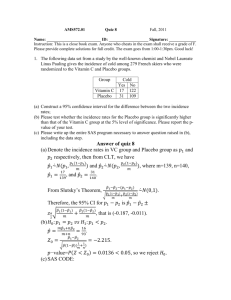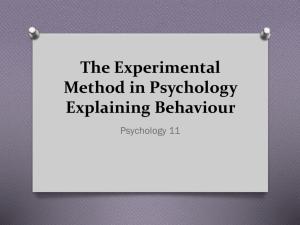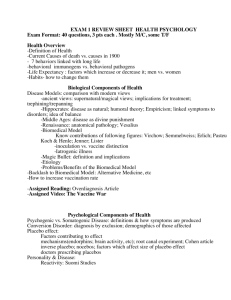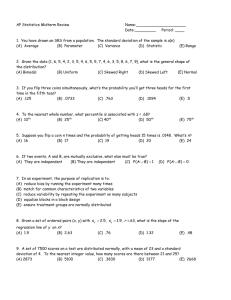Slides - Clinical Trial Results
advertisement
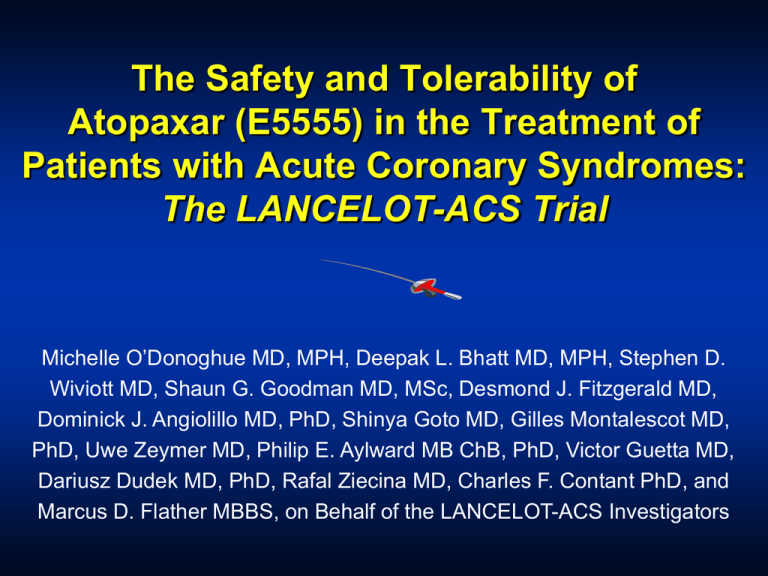
The Safety and Tolerability of Atopaxar (E5555) in the Treatment of Patients with Acute Coronary Syndromes: The LANCELOT-ACS Trial Michelle O’Donoghue MD, MPH, Deepak L. Bhatt MD, MPH, Stephen D. Wiviott MD, Shaun G. Goodman MD, MSc, Desmond J. Fitzgerald MD, Dominick J. Angiolillo MD, PhD, Shinya Goto MD, Gilles Montalescot MD, PhD, Uwe Zeymer MD, Philip E. Aylward MB ChB, PhD, Victor Guetta MD, Dariusz Dudek MD, PhD, Rafal Ziecina MD, Charles F. Contant PhD, and Marcus D. Flather MBBS, on Behalf of the LANCELOT-ACS Investigators LANCELOT-ACS Disclosures LANCELOT-ACS was funded by Eisai, Inc. M. O’Donoghue has received grant funding from Eisai, Inc and GlaxoSmithKline, and has received honoraria from GlaxoSmithKline, Daiichi Sankyo and Eli Lilly. LANCELOT-ACS Oral Anti-Platelet Therapies P2Y12 Inhibition: Clopidogrel Ticlodipine Prasugrel Ticagrelor Elinogrel ADP ADP P2Y12 Thrombin PAR-1 Inhibition: Atopaxar (E5555) Vorapaxar cAMP PAR-1 PLATELET COX GP IIb/IIIa (Fibrinogen receptor) ADP TXA2 Aspirin Adapted from Schafer. Am J Med. 1996;101:199-209. Activation Collagen TXA2 LANCELOT-ACS Primary Objective To investigate the safety and tolerability of atopaxar (E5555) in subjects admitted to the hospital with symptoms of an acute coronary syndrome (ACS) LANCELOT-ACS Key Secondary Objectives • To determine the effects of atopaxar on the incidence of major adverse cardiac events (MACE), including CV death, myocardial infarction (MI), stroke, or recurrent ischemia • To determine the effect of atopaxar on the incidence of transient ischemia by continuous ECG (Holter) • To determine the effect of atopaxar on platelet aggregation (at selected sites) LANCELOT-ACS Subjects with ACS n = 603 (Unstable angina or NSTEMI) Randomization within 72 hours of symptom onset Randomize 1:1:1:1 Double-blind Placebo QD Atopaxar 400mg LD, 50mg QD Atopaxar 400mg LD, 100mg QD Atopaxar 400mg LD, 200mg QD 12 Weeks Active Treatment, 4 Weeks Follow-Up Primary Endpoint: Major bleeding (CURE) at 12 weeks LANCELOT-ACS Inclusion Criteria • Male or female; aged 18-80 years • Presenting with features of unstable angina or nonST-elevation MI • At least one of the following: 1. 2. Troponin T or I or CK-MB upper limit of normal ECG changes compatible with ischemia (i.e. ST depression at least 1 mm in 2 contiguous leads or T wave inversion > 3 mm or any dynamic ST shift or transient ST elevation) • Randomization and treatment ≤ 72 hours of the onset of symptoms LANCELOT-ACS Major Exclusion Criteria • Increased risk of bleeding, anemia (Hb <10 g/dL), thrombocytopenia (<100x103/μL), history of pathological intracranial findings • Planned elective major surgery • Planned use of oral anticoagulants (e.g., warfarin), fibrinolytics, or regular NSAIDs • Known hepatic disease or creatinine clearance <30 ml/min LANCELOT-ACS Trial Organization Principal Investigators Marcus D. Flather, MBBS Deepak L. Bhatt, MD, MPH TIMI Study Group Brigham and Women’s Hospital Harvard Medical School Eugene Braunwald, MD Michelle O’Donoghue, MD, MPH Stephen D. Wiviott, MD Clinical Events Committee: Cleveland Clinic ECG Core Lab: Shaun Goodman, MD, MSc Platelet Function Study: Java Clinical Research Sponsor: Eisai, Inc. Desmond J. Fitzgerald, MD Data Safety Monitoring Board: Richard C. Becker, MD (Chair) Frederick Spencer, MD Kerry Lee, PhD Freek Verheugt, MD Jeffrey I. Weitz, MD Christopher P. Cannon, MD (1st meeting only) Lee Golden, MD Rafal Ziecina, MD LANCELOT-ACS Top Enrolling Countries (184 sites, 22 countries) Poland 22.7% Bulgaria 4.1% India 15.6% Italy 1.8% Russia 13.3% UK 1.8% Israel 9.3% France 1.7% Germany 7.1% Argentina 1.5% Belgium 6.6% USA 1.5% South Africa 4.8% Australia 1.3% LANCELOT-ACS Baseline Characteristics Atopaxar Placebo (N=142) 50mg (N=156) 100mg (N=157) 200mg (N=148) Active Total (N=461) Age (Year), median 62.0 59.0 61.0 61.5 60.0 Male 67% 71% 72% 64% 69% Current tobacco use 25% 31% 32% 33% 32% Diabetes mellitus 21% 25% 21% 23% 23% Dyslipidemia 50% 48% 48% 49% 48% Peripheral artery disease 3.6% 2.6% 10% 6.8% 6.5% Hypertension 71% 70% 68% 73% 70% Prior MI 30% 19% 22% 30% 24% Prior PCI 17% 16% 12% 19% 16% Prior CABG 7.9% 7.1% 9.6% 6.8% 7.8% Prior TIA or Stroke 1.4% 3.9% 5.1% 6.1% 5.0% Congestive Heart Failure 16% 12% 10% 14% 12% LANCELOT-ACS Concomitant Therapies Placebo (N=142) Atopaxar 50 mg (N=156) 100 mg (N=157) 200 mg (N=148) Active Total (N=461) Aspirin 98% 96% 94% 95% 95% Thienopyridine 84% 82% 78% 79% 80% Statin 90% 90% 88% 81% 86% Beta blocker 85% 88% 82% 85% 85% Glycoprotein IIb/IIIa inhibitor 19% 14% 18% 16% 16% LANCELOT-ACS Incidence of any CURE Bleeding 7.0% CURE minor 5.8% 6.0% CURE major P trend = 0.81 5.0% 2.6% 4.0% 3.1% 3.0% 2.2% 1.3% 2.0% 1.0% 2.1% 1.3% 2.2% 1.8% 0.7% 3.2% 0.7% 1.4% 0.6% 0.0% Placebo n=138 Active combined atopaxar 50mg QD 100mg QD 200mg QD n=153 n=156 n=146 n=455 Relative Risk (95% CI) vs. placebo RR 1.42 (0.44-4.8) RR 0.60 (0.11-3.00) RR 2.65 (0.78-10.3) P = 0.63 P = 0.62 P = 0.13 RR 0.95 (0.18-5.04) P = 0.99 LANCELOT-ACS Incidence of any TIMI Bleeding 14% 12% TIMI minimal TIMI minor TIMI major 10% P trend = 0.63 8% 8.3% 6% 9.4% 7.3% 6.2% 7.2% 4% 1.3% 2% 0% 0.7% 0.7% 1.3% Placebo Active combined atopaxar n=138 2.6% 1.4% 0.7% 50mg QD n=153 100mg QD n=156 200mg QD n=146 n=455 RR (95% CI) vs. placebo RR 0.91 (0.52-1.63) RR 0.77 (0.38-1.60) RR 1.20 (0.63-2.29) RR 0.74 (0.35-1.56) P = 0.77 P = 0.53 P = 0.60 P = 0.46 LANCELOT-ACS Incidence of CV death, MI, Stroke, or Recurrent ischemia P trend = 0.26 12.0% 10.8% 10.0% 8.0% 9.5% 7.8% 8.0% 6.0% 3.9% 4.0% 2.0% 0.0% Placebo n=142 Active combined atopaxar 50mg QD n=156 100mg QD n=157 200mg QD n=148 n=461 RR (95% CI) vs. placebo RR 1.04 (0.55-1.97) P = 0.93 RR 0.50 (0.16-1.27) RR 1.40 (0.68-2.86) RR 1.22 (0.58-2.57 P = 0.18 P = 0.37 P = 0.63 LANCELOT-ACS Incidence of CV death, MI, or stroke 12.0% P trend = 0.28 10.0% 8.0% 6.0% 5.7% 5.6% 4.0% 3.3% 2.0% 1.9% 2.0% 0.0% Placebo n=142 Active combined atopaxar 50mg QD n=156 100mg QD n=157 200mg QD n=148 n=461 RR (95% CI) vs. placebo RR 0.58 (0.25-1.41) P = 0.20 RR 0.34 (0.10-1.18) P = 0.10 RR 1.02 (0.41-2.50) RR 0.36 (0.11-1.24) P = 0.99 P = 0.12 LANCELOT-ACS Incidence of Holter-Detected Ischemia at 48 Hours following 400mg Loading Dose 30.0% 28.1% RR 0.67 (95% CI 0.48-0.94) P = 0.02 25.0% 20.0% 18.7% 15.0% 10.0% 5.0% n=128 n=433 0.0% Placebo Active combined atopaxar LANCELOT-ACS Platelet Function Data - Loading Dose Phase* Thrombin receptor-activated peptide (TRAP, 15 µM)induced inhibition of platelet aggregation Mean TRAP-induced IPA (%) 100 80 92% 89% 3-6 hour Day 2 Pre-dose 74% 60 40 20 0 1-3 hour n=38 *400 mg loading dose n=34 n=39 LANCELOT-ACS Platelet Function Data - Maintenance Dose Phase Thrombin receptor-activated peptide (TRAP, 15 µM)induced inhibition of platelet aggregation Mean TRAP-induced IPA (%) 50mg QD 100mg QD 200mg QD 100 80 90% 95% 77% 97% 95% 84% 79% 76% 63% 60 40 20 0 Week 2 Week 4 Week 8 n=42 n=37 n=39 LANCELOT-ACS Incidence of ALT ≥ 3x ULN Incidence of ALT ≥ 3x ULN (%) 6 Cumulative incidence ALT ≥ 3x ULN at Week 12 Placebo 50 mg QD 5 100 mg QD 200 mg QD 4 Placebo: 2.48% 50 mg QD: 2.19% 100 mg QD: 2.17% 200 mg QD: 5.47% 3 2 1 0 Week 2 Week 4 Week 8 No cases of Hy’s Law were observed Week 12 Week 16 3 subjects with LFT changes discontinued drug LANCELOT-ACS QTc Interval ∆ in QTc from baseline to end-of-treatment (ms) Atopaxar Placebo 50mg 100mg 200mg • Overall shortening of QTc was seen in all study arms from randomization to end of treatment • The mean decrease in QTc was greater in the placebo group than the combined atopaxar group (P=0.04) • This effect was dose-dependent • There were no associated cases of syncope or known malignant arrhythmias 0 -2 -4 -4.5 * -6 -8 -10 -12 -9.9 -4.9 * -11.4 P for trend = 0.07 * P<0.05, for comparison with placebo LANCELOT-ACS Conclusions • Atopaxar achieves potent and rapid platelet inhibition via the PAR-1 receptor without a significant increase in bleeding in patients with ACS • Favorable trends for efficacy were supported by a significant reduction in Holter-detected ischemia • Overall the drug was well tolerated, but dose-dependent transaminitis and relative QTc prolongation were observed with the higher doses of atopaxar • Future studies will be required to fully establish safety and efficacy of atopaxar, but PAR-1 blockade appears promising

